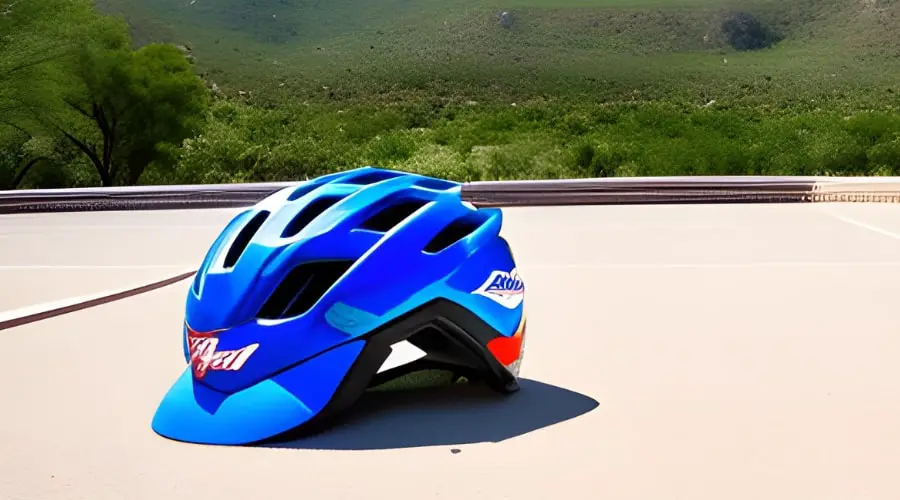As a cyclist, your safety is paramount, and your helmet is your best defense against head injuries. However, accidents happen, and your helmet may take a hit from time to time. But does dropping a bicycle helmet ruin it? In this article, we will discuss the impact of dropping a bicycle helmet and what you should do if it happens.

Understanding Bicycle Helmet Construction
Bicycle helmets consist of several layers of material, each with a specific purpose:
- Outer Shell: The outer shell is usually made of polycarbonate, a lightweight and durable plastic that can withstand impact and resist punctures.
- Impact-absorbing Liner: The liner is typically made of expanded polystyrene (EPS) foam. The foam is designed to crush and absorb the force of impact during a crash, protecting your head from injury.
- Retention System: The retention system holds the helmet in place on your head. It is usually made of nylon straps and a plastic buckle that can be adjusted to fit your head securely.
- Comfort Padding: Comfort padding lines the interior of the helmet and is usually made of foam or cloth to provide cushioning and improve the fit.
How Dropping Affects Bicycle Helmets
Dropping a bicycle helmet can cause damage to the helmet’s construction, reducing its ability to protect your head. A hard impact can cause the outer shell to crack or split, compromising the helmet’s ability to distribute the force of impact. The EPS foam liner can also compress or deform, reducing its ability to absorb impact.
Even a minor impact can cause damage that may not be visible to the naked eye. Hairline cracks or splits in the outer shell or compression of the EPS foam liner can compromise the helmet’s safety. Dropping a helmet can also damage the retention system, which can result in the helmet slipping or coming off during a crash.
How long do bicycle helmets last
Bicycle helmets have a limited lifespan and should be replaced periodically, regardless of whether they have been dropped or not. Most manufacturers recommend replacing your helmet every five years, although this may vary depending on the helmet’s use and storage conditions.
Over time, the materials in the helmet can degrade, reducing its ability to protect your head. Exposure to heat, sunlight, and chemicals can also cause the helmet’s materials to break down, compromising its safety. Additionally, sweat and other body fluids can break down the helmet’s foam liner, reducing its ability to absorb impact.
It is essential to inspect your helmet regularly for signs of damage, even if it has not been dropped. If you find any cracks, splits, or other signs of damage, it is time to replace the helmet. Even if the damage seems minor, it is best to err on the side of caution and invest in a new helmet to ensure your safety.
Investing in a high-quality helmet and replacing it periodically is one of the best ways to protect yourself while cycling. A good helmet can save your life in the event of a crash and provide peace of mind while you ride.

How to Inspect Your Helmet for Damage
It is essential to inspect your helmet regularly for damage, especially after it has been dropped. The following steps will help you identify any damage:
- Check the outer shell: Look for cracks, splits, or punctures in the outer shell. If you find any damage, it is time to replace the helmet.
- Inspect the liner: Remove the comfort padding and inspect the EPS foam liner for signs of compression or deformation. If you can see visible signs of damage, such as cracks or dents, it is time to replace the helmet.
- Check the retention system: Check the nylon straps and plastic buckles for signs of damage or wear. If the buckle is broken or the straps are frayed, it is time to replace the helmet.
- Replace the helmet: If you find any damage during the inspection, it is time to replace the helmet. Even if the damage is not visible, it is best to err on the side of caution and replace the helmet.
What to Do If Your Helmet is Damaged
If your helmet is damaged, you should replace it immediately. A damaged helmet will not provide adequate protection in the event of a crash, and it may even increase
If your helmet is damaged, you should replace it immediately. A damaged helmet will not provide adequate protection in the event of a crash, and it may even increase your risk of head injury. Do not try to repair the helmet or use it again, even if the damage seems minor. It is best to invest in a new helmet to ensure your safety on the road.
When shopping for a new helmet, look for one that meets the safety standards of your country or region. Helmets certified by organizations such as the Consumer Product Safety Commission (CPSC) in the US or the European Union’s CE mark meet rigorous safety standards and provide reliable protection.
Related: Can You Wear a Dirt Bike Helmet on a Bicycle?
FAQs:
How often should I replace my helmet?
You should replace your helmet every five years, regardless of whether it has been dropped or not. Over time, the materials in the helmet can degrade, reducing its ability to protect your head.
Can I still use my helmet if it has been dropped?
If your helmet has been dropped, you should inspect it for damage and replace it if you find any signs of damage. Even if the damage seems minor, it is best to invest in a new helmet to ensure your safety.
Can I repair a damaged helmet?
No, you should never try to repair a damaged helmet. A damaged helmet will not provide adequate protection in the event of a crash, and it may even increase your risk of head injury. Always replace a damaged helmet with a new one.
Do more expensive helmets provide better protection?
Not necessarily. All helmets that meet safety standards provide similar levels of protection, regardless of their price. However, more expensive helmets may offer additional features such as improved ventilation or a more comfortable fit.
Can I use a second-hand helmet?
No, you should never use a second-hand helmet. Helmets are designed to absorb the force of impact during a crash, which can cause invisible damage to the helmet’s construction. A second-hand helmet may have hidden damage that reduces its ability to protect your head. Always invest in a new helmet to ensure your safety.
Conclusion
Dropping a bicycle helmet can cause damage that compromises its ability to protect your head. It is essential to inspect your helmet for damage regularly and replace it immediately if you find any signs of damage. A damaged helmet is a risk to your safety and should never be used again, even if the damage seems minor.
Invest in a high-quality helmet that meets the safety standards of your country or region. A good helmet can save your life in the event of a crash and provide peace of mind while you ride.
Helmetslab is a website that focuses on providing in-depth reviews and information about different types of helmets, including motorcycle helmets and others helmets. I am writing a post with proper research on the info that helps helmet users.

